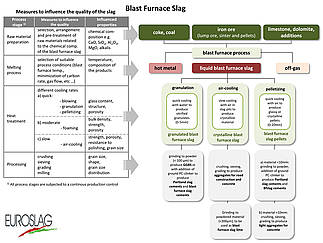Blast furnace slag
Blast furnace slag is formed during the production of hot metal by thermo-chemical reduction in a blast furnace. During this continuous process, iron ore or pellets as well as fluxes (lime[stone] and/or dolomite) are heated under reducing conditions in the presence of heated air. Coke and other reducing agents (e.g. injected coal) are combusted to produce carbon monoxide which reduces the iron ore or pellets to liquid hot metal.
The fluxes, the residues from the carbon source and the non-metallic components of the iron ore are chemically combined and result in the non-metallic liquid blast furnace slag. Hot metal and liquid slag accumulate at the bottom of the blast furnace, where the less dense slag forms a layer above the molten iron and can be separated in the skimmer. The temperature of the blast furnace slag at tapping is around 1500 °C.
When the slag is tapped from the furnace, it can be treated in a number of ways. If it is directed into pits or ground bays where it air-cools slowly, it will form a crystalline structured rock-like mass which is called air-cooled blast furnace slag (ABS). When the liquid slag is directed into a granulator where it is rapidly cooled by large amounts of water, it results in a glassy/amorphous granular or sand-like product called granulated blast furnace slag (GBS). To a lesser extent, blast furnace slag is also pelletized to form blast furnace pellets or it is foamed to produce foamed blast furnace slag (see flow chart).
After crushing and screening, air-cooled blast furnace slag (ABS) provides an eminently suitable material for use as a construction aggregate in bound or unbound form, like any natural rock.
Granulated blast furnace slag (GBS) exhibits cementitious properties and is thus used as hydraulic binder for cement, concrete, mortar and grout. For this purposes, it is ground, separately or together with Portland cement clinker and calcium sulphate and is referred to as ground granulated blastfurnace slag (GGBS). Unground GBS can be used as an aggregate for e.g. road construction.

